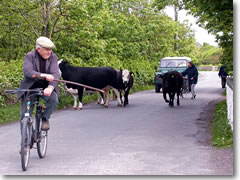Driving in Europe
Except for driving on the left in Great Britain and Ireland, European road rules are similar enough to American ones that you'll get by fine. There are, however, some important differences.

Traffic jams in Europe often involve far more than cars—like bicycles, pedestrians, cows, sheep...
The Rules of the Road
The most important rule of thumb for driving in any foreign country is this: Accept that the locals know the rules of the road—both the traffic laws and the unspoken rules—far better than you do.
Take your lead from them and drive as they do, only more slowly and tentatively.
In fact, drive with an unusual degree of caution to avoid making too many mistakes (or at least avoid making them at high speed).
All of Europe drives on the right side of the road except the countries of the British Isles.
In England, Scotland, Wales, and Northern Ireland—as well as the Republic of Ireland—they drive on the left.
On multi-lane highways, do not just cruise along in the left lane (right lane British Isles).
In Europe, the fast lane truly is only for passing (or for cars with massive engines that spend their entire trips passing other cars).
In fact, passing other cars has been raised to a fate-tempting art form in Europe, wher eit is no unusual for someone to pass you at high speed on a blind curve (once, memorably, this happened to me inside a tunnel in Italy).
Please, pelase, please do not try this yourself.
If someone comes barelling up from behind and flashes their lights at you, it's a signal for you to slow down and drive more on the shoulder so that they can pass you more easily (two-lane roads here routinely become three cars wide).
I know: obvious one, right? Problem is, there's this persistent myth that there are no speed limits in Europe. This is untrue. Except for some parts of the German Autobahn, most European highways do indeed have speed limits of around 100 to 135 kilometers per hour (60 to 80 mph).
While traditionally speed limits in Europe were widely ignored and rarely enforced, in recent years this has been changing. More and more cops have begun writing speedng tickets and—more insidiously—more and more tickets are being issued automatically from traffic cams.
Since these tickets only find their way to you via the rental car company—and the rental company will tack on enormous fees of their own to pass them along to you—you would be very wise to stick to the posted limits.
In Europe, everything's measured in kilometers (mileage and speed limits). For a rough conversion, one kilometer equals a weensy bit more than 0.6 miles—so just divide the amount in half and add back ten percent.
In other words, to render 120km in miles, take half—60 miles—then add to that ten percent of 120—12 miles. So that's 60 + 12 for a total of 72 miles.
So if a road sign says the next town is 120km away, that's about 72 miles.
If your speedometer says you're going 120 kph, that means you're going way too fast (remember: slow and cautious). Ease off to 100 kph or less (about 60 mph).
» More on metric conversions.
That gas may look reasonably priced, but remember the posted price is per liter, not per gallon—and it's in euros, not dollars.
Gas in Europe is preposterously pricey, averaging (in 21013) around $7–$9 a gallon—with a range from roughly $6.50 per gallon in Romania up to $10 per gallon in Norway. No foolin'.
Budget accordingly when deciding between taking a train or renting a car.
For an American to get an accurate sense of how much gas costs, you have to multiply the per-liter price by 3.8 to get gallons (doing it in your head, just use 4), then multiply that by the current exchange rate (estimate about $1.35 to €1) to get it into dollars.
Then have someone with a defibrillator handy get your heart started again.
» More on metric conversions.
I cannot stress this enough: Assume the other drivers have a better idea of what they're doing than you do, and take your hints from them.
One thing to note: Most European drivers are much more aggressive than American ones. Be prepared, and leave the road rage at home.
Never leave anything visible in the car when you park it. When you check into a hotel, take all of your luggage ino your hotel with you, even if you won't be needing it that night (such as souvenir purchases).
This advice goes doubly in Italy and triply in Naples (any port city, really).
» More on losing things.
Bring your driver's license, of course, But if you do plan to drive in Europe, you may want to bring (although it's not required) an International Driver's Permit and carrying it in addition to your regular driver's license (it merely translates the data into several languages). It costs $15 from AAA (you don't have to be a member).
If you are a AAA member, ask for any free info and maps they can send you to cover the countries in which you'll be driving.
Some countries, such as Austria and Switzerland, require that cars riding the national highways have special highway stickers in lieu of paying tolls (or as a supplement to cheap tolls).
If you rent a car within that country, the car already has one, but if you're crossing a border, check at the crossing station to see whether you need to purchase a sticker on the spot for a nominal fee.
Related Articles |
Related Partners |
This article was by Reid Bramblett and last updated in April 2011.
All information was accurate at the time.
Copyright © 1998–2013 by Reid Bramblett. Author: Reid Bramblett.
